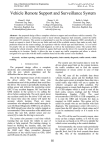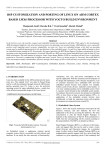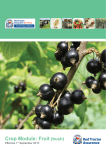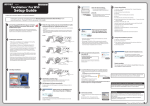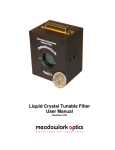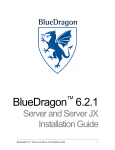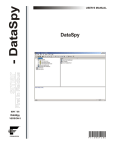Download Weevil User Manual
Transcript
Weevil User Manual Yanyan Wang Software Engineering Research Laboratory Department of Computer Science University of Colorado Boulder, Colorado 80309-0430 USA [email protected] c 2003–2004 Yanyan Wang 1 Weevil A particular experiment is related to three primary concepts: the system under experimentation (SUE), the testbed and the actor. An actor maps a client to its system access point and actuates the SUE as dictated by the client’s workload. An experiment can be understood as a two-phase process in which (1) a workload is generated for the actors, (2) the SUE is deployed on the testbed with the actors actuating it based on the workload and the results are collected afterward. Weevil supports the two-phase process through a central-controller architecture in which a master script controls the whole process. Workload generation is conducted on the master’s host as presented in Section 2. In the experiment deployment and execution phase (described in Section 3) the master generates all the controls, deploys them together with the workload and the SUE on the testbed, coordinates all the system components and the actors to execute the experiment, and gathers data after the experiment terminates. The two program weevilgen and weevil, are for workload generation and experiment deployment and execution respectively. Throughout the following sections, we refer to the Siena example and the Squid/Apache example included in the prototype distribution under share/weevil-1.0.0/examples. 2 Simulation-Based Workload Generation Weevil’s simulation-based workload generation process supported by the package weevilgen is illustrated in Figure 1. actor behavior a.cc a2.c a3.c actor configuration scenario definition simulation setup workload scenario discrete−event weevil workload− simulation library generation library simulation program simulation execution actor time action a12 10 sub... unified b5 23 pub... workload ... ... ... Figure 1: Simulation-Based Workload Generation In detail, the following steps need to be taken in order. 2.1 Weevilgen Configuration (Workload Registration) Create a name for the workload (refered to as <workload name> below), like “MyWorkload” in the Siena example; add the name into “weevil.conf ” file after “weevilgen WORKLOADS:=”. You could have more than one workload registered in “weevil.conf ” separated with space, as indicated in the apachesquid example. To start a new line, \ is needed to end the current line. Weevilgen only generates workloads that have been registered in “weevil.conf ”. For example, in file “weevil.conf ” of the Squid/Apache example we registered a series of workloads: weevilgen_WORKLOADS := wkld_10_10_10 wkld_20_20_20 wkld_30_30_30 \ wkld_50_50_50 wkld_100_100_100 wkld_150_150_150 wkld_200_200_200 wkld_30 \ wkld_60 wkld_90 wkld_150 wkld_300 wkld_450 wkld_600 wkld_tp wkld_gsl 1 Then, to generate each workload, Weevil must be provided with programmed actor behavior models as illustrated in Section 2.2 and an actor configuration file named “<workload name>.m4” including all the actor configurations as illustrated in Section 2.3. 2.2 Actor Behavior Model Programming One or more types of actor behaviors could be programmed in C++ with the support of Weevil’s workload-generation library and SSim simulation library, and may therefore execute arbitrary functions and maintain arbitrary state. SSim is a discrete-event simulation library that supports message communication between simulated processes, so actor behavior programs may specify interactions with other actors. Weevil’s workload-generation library extends the SSim’s library by providing a workload-output method and convenient methods for dealing with processes by ids. Please refer to the Weevil’s workload-generation library and the SSim’s simulation library in the reference manual when programming your actor behavior model. Basicly, actor behavior is encapsulated in a subclass of the weevil::WeevilTProcess class or the weevil:: WeevilProcess class. weevil::WeevilTProcess, which is a sequential process, is the extension of the ssim::TProcess class. A sequential actor behavior is defined simply by programming the main method, which defines the body of the process directly. A process can use the WeevilGen::broadcast event, WeevilGen:: self signal event and WeevilGen::signal event method defined in Weevil’s library to signal itself or other processes, and the wait for event method to receive events. In contrast, weevil::WeevilProcess, which is a reactive process, is the extension of the ssim::Process class. It is used when the process may have other reactive behaviors in parallel to its routine behaviors. A reactive actor behavior is defined by programming the init and the process event methods. Init initiates the process just before the simulation starts. Process event is called automatically by an event and defines the functions executed by the process in response to an event. Same as the weevil::WeevilTProcess, the event can be signaled using the WeevilGen::broadcast event, WeevilGen::self signal event and WeevilGen::signal event methods. Both of the above two types of processes can use the method workload output() to output actions to the workload. As examples of the usage of these two types, we consider the following two types of interdependent behaviors. 2.2.1 Intra-Actor Interdependent Behavior One type of interdependent behavior is one where future requests need to incorporate data from a previous request. As an example, consider a distributed publish/subscribe system where actors use an access point to publish notifications and subscribe for notifications of interest. A common behavior for a subscriber actor could be to periodically subscribe and unsubscribe, with every unsubscription matching the previous subscription, then continue with the next subscription. We implemented this behavior in examples/siena/subscriber.cc. (It is used to generate workload wkld sequential.wkld.) Notice that in this case, the behavior is represented as a sequential process class and is defined simply by programming the main method of that class. Similarly, Weevil can easily generate workloads for various types of session-oriented protocols, where actors maintain a virtual connection with the system by providing an immutable session identifier throughout their interaction with the system. 2.2.2 Inter-Actor Interdependent Behavior Another type of interdependent behavior is one where actors communicate and coordinate their interactions with the SUE. We consider a scenario in which three siena clients are involved. They have their routine behaviors. C1 subscribes 50 times, C2 publishes 40 times, and C3 publishes 20 times. Besides, they also communicate and may have reactive actions triggered by others. To generate a workload, we consider each client as a reactive workload process SienaClient, the subscription, notification, and unsubscription as the possible actions of that process to be outputed to a workload file. The communication between clients is represented by a Trigger object. The configuration of each workload process consists 2 of the number of its routine actions, the intervals between actions, those parameters used to generate the content of subscriptions and notifications, and the list of clients to whom the current client will trigger after its own action. The code to implement this behavior model could be found in examples/siena/sienaclient.cc. (It is used to generate workload MyWorkload.wkld.) Notice that in this case, the behavior is defined as a reactive process by implementing the init and process event methods. The Trigger class represents an event signaled to a simulation process. The init method initializes workload processes just before the simulation starts but after the assignment of process properties. Notice also that the configuration of each workload process is implemented with the help of actor configurations described later in Section 2.3. Corresponding to each property declared in the actor configurations, a class variable and a class function need to be defined in the behavior program, such as, //class variable unsigned int m_constr_min; //class function void constr_min( unsigned int cmin ) { m_constr_min = cmin; } in the file “sienaclient.cc” corresponds to the property configuration WVL_SYS_WorkloadProcessProp( ‘C1’, ‘constr_min’, ‘1’)dnl WVL_SYS_WorkloadProcessProp( ‘C2’, ‘constr_min’, ‘2’)dnl WVL_SYS_WorkloadProcessProp( ‘C3’, ‘constr_min’, ‘1’)dnl in the actor configuration file “MyWorkload.m4”. 2.3 Actor Configurations After programming the actor behavior models, you can populate a scenario consisting of many actor instances specified in the actor configuration file named “<workload name>.m4”. The actor behavior models and the actor configurations make up a workload scenario definition. WorkloadScenario WorkloadProcess + ID : String + stoptime : int + ID : String + props : Property[] ExternalLibrary + ID : String + cflags : String + libs : String + path : String WorkloadProcessType + ID : String + srcFiles : String[] Figure 2: Workload Scenario Conceptual Model Figure 2 shows the portion of the Weevil conceptual model concerning the definition of workload scenarios. You need to parameterize the following GNU m4 declaration macros in the actor configuration file. The order of the declarations does not matter. A macro can be used before it is defined as long as it is defined somewhere in the actor configuration file. Weevil supports the engineer during this activity by performing extensive checks on the syntax and consistency of the configurations and by providing detailed error messages about any problems it encounters. • WVL SYS WorkloadScenario(<ID>, <length>, <processes>) A WorkloadScenario has an identifier and a collection of processes. The argument <length > defines the number of clock ticks in the simulation. If you define this argument, the simulation will end as long as the clock-tick number is reached even if the actors have not finished their work. For example, 3 define(‘clients’, ‘C1, C2, C3’)dnl WVL_SYS_WorkloadScenario( ‘MyWorkload’, ‘10000’, ‘clients’)dnl • WVL SYS WorkloadProcessType(<ID>, <sourceFiles>, <libraries>) A WorkloadProcessType defines an actor behavior model in a list of sourceFiles as described in Section 2.2, and may be associated with a collection of libraries that contain external dependencies of the implementation. Please note that none of the file names of the .cc files in the sourceFiles list can be the same as the workload name you registered in the weevil.conf since a <workload name>.cc will be generated in the workload generation process. The source files should list all the C++ files in the order of file inclusion. For example, WVL_SYS_WorkloadProcessType( ‘SienaClient’, ‘gen_message.h, gen_message.cc, sienaclient.cc’, ‘’)dnl In this example, instead of adding the statement #include ‘‘gen message.h’’ in both gen message.cc and sienaclient.cc, we only need to put gen message.h before gen message.cc and sienaclient.cc in the <source files> parameter of this declaration macro. The Squid/Apache’s wkld gsl example that generates workloads based on analytic models uses the GNU scientific library libgsl declared later: WVL_SYS_WorkloadProcessType( ‘AnalysisBrowser’, ‘analysisbrowser.cc’, ‘libgsl’)dnl • WVL SYS ExternalLibrary(<ID>, <cflags>, <libs>, <path>) This declaration defines the usage of an external library, including its cflags, its libs, and the path to add into the environment variable LD LIBRARY PATH. For example, the external library “libgsl” used above is declared as follows: WVL_SYS_ExternalLibrary( ‘libgsl’, ‘-I/usr/include -L/usr/lib’, ‘-lgsl -lgslcblas -lm’, ‘/usr/lib’)dnl • WVL SYS WorkloadProcess(<ID>, <type>) Each WorkloadProcess represents an actor, which is an instance of a WorkloadProcessType. For example, define(‘clients’, ‘C1, C2, C3’)dnl WVL_SYS_Foreach(‘i’, ‘WVL_SYS_WorkloadProcess( i, ‘SienaClient’)’, clients)dnl defines three instances of the WorkloadProcessType SienaClient (C1, C2, C3). • WVL SYS WorkloadProcessProp(<workloadProcessID>, <name>, <value>) This declaration macro is used to configure each defined process. Corresponding to each property, a class variable and a class function need to be defined in the actor behavior program to assign the value of the property to the class variable. Besides the example we gave in Section 2.2, another example could be the property“sub neighbors”: 4 WVL_SYS_WorkloadProcessProp( ‘C1’, ‘sub_neighbors’, ‘"C2 PUB 3 0.02|C3 SUB 2 0.01|"’)dnl WVL_SYS_WorkloadProcessProp( ‘C2’, ‘sub_neighbors’, ‘"C3 SUB 2 0.02|"’)dnl WVL_SYS_WorkloadProcessProp( ‘C3’, ‘sub_neighbors’, ‘"C1 PUB 5 0.01|"’)dnl corresponds to the class variable “m sub neighbors” and function “sub neighbors” in program “sienaclient.cc”. The function “sub neighbors” parses the string in the parameter <value> to assign the variable “m sub neighbors”. 2.4 workload generation With the actor behavior models programmed and actor instances configured for a workload scenario, Weevil checks them for consistency and then translates them into an executable simulation program that is linked with the libraries and then executed to produce the desired workload named “<workload name>.wkld”. The workload consists of all interactions between actors and the SUE. These interactions represent service calls that must be applied to the SUE during experiment execution. This process is accomplished through the command “weevilgen gen-<workload name>”. examples/apachesquid> ${execPath}/weevilgen help Welcome to WEEVIL WORKLOAD GENERATOR. The following commands are available: check-all check-<workload> clean-all clean-<workload> help gen-all gen-<workload> version - checks all workloads. checks a workload’s settings. cleans files for all workloads. removes all generated files for a workload. prints this help message generates all workloads. generates a workload. prints the version of weevil workload generator The following workloads are available: wkld_10_10_10 wkld_20_20_20 wkld_30_30_30 wkld_50_50_50 wkld_100_100_100 wkld_150_150_150 wkld_200_200_200 wkld_30 wkld_60 wkld_90 wkld_150 wkld_300 wkld_450 wkld_600 wkld_tp examples/apachesquid> ${execPath}/weevilgen gen-wkld_10_10_10 Besides the “gen-<workload name>” option, you can also use the other options listed above for different functions. 3 Experiment Deployment and Execution Weevil directly supports experiment deployment and execution. The overall process is depicted in Figure 3. Actions are represented by rectangles and are labeled by circled numbers. Input and output data for those actions are represented by ovals. Dark ovals represent input models provided by the engineer. White ovals represent data generated by Weevil or by the SUE during experiment. Solid arrows represent normal input/output data flow, whereas dotted arrows represent the execution of scripts. The following steps need to be taken to setup and conduct an experiment. 3.1 Weevil Configuration (Experiment Registration) Create a name for the experiment (refered to as <experiment name> below), like ”experiment” in the siena example; add the name into ”weevil.conf ” file after ”weevil EXPERIMENTS:=”. You could have more than one 5 unified workload 2 experiment configuration file host actor SUE mapping mapping workload partitioning makefile gen. makefile actor workloads 1 start/stop scripts 4 testbed script gen. master script deployment 3 cleanup scripts cleanup 7 per−machine test data 5 execution log files 6 data collection Figure 3: Weevil Experimentation Process experiment registered in ”weevil.conf ” separated with space, as indicated in the apachesquid example. To start a new line, \ is needed to end the current line. weevil only conducts experiments that have been registered in ”weevil.conf ”. For example, in file “weevil.conf ” of the Squid/Apache example we defined a series of experiments: weevil_EXPERIMENTS := exp_10_10_10 exp_20_20_20 exp_30_30_30 \ exp_50_50_50 exp_100_100_100 exp_150_150_150 exp_200_200_200 exp_30 \ exp_60 exp_90 exp_150 exp_300 exp_450 exp_600 For each experiment, Weevil must be provided with a workload file (refer to Section 3.2) and an experiment configuration file named “<experiment name>.m4” including all the experiment configurations as illustrated in Section 3.3. 3.2 Workload File You can generate the workload file with weevilgen. Of course, you can always use workloads from other workload generators or just use a real trace as the workload. But please note that the workload should be made up of workload lines with the following format: event(<time stamp>, <workload process ID>, ‘<event content>’) 3.3 Experiment Configurations These configurations are represented by the dark ovals along the top of Figure 3. They are programmed in GNU m4 by parameterizing Weevil-defined declaration macros (Please refer to the “Weevil’s Experiment Environment Declaration Macros”) to instantiate elements of two conceptual models (SUE and testbed) and necessary mappings (Please refer to the “Weevil’s Experiment Environment Conceptual Models”). In other words, these declaration macros will define a set of macros serving as properties of an experiment. (Please refer to the “Weevil’s Experiment Environment Declaration Macros” and the “Some Other Weevil-Defined Property Macros”) for these property macros.) The order of the declarations does not matter. A macro can be used before it is defined as long as it is defined somewhere in 6 the experiment configuration file. Weevil supports the engineer during this activity by performing extensive checks on the syntax and consistency of the configurations and by providing detailed error messages about any problems it encounters. These declaration macros are defined below: Experiment WVL SYS Experiment(<ID>, <workload>, <actors>, <testbed>, <sue>, <componentHosts>) This declaration macro defines the experiment to be conducted, including its workload, actor mapping, testbed, SUE, and host mapping. All of these properties will be specified using further declaration macros. Note that the ID of an experiment can be different from the experiment name you registered in the “weevil.conf ” file. For example, the experiment with name “experiment” in Siena example is defined as: WVL_SYS_Experiment(‘Exp_0’, ‘MyWorkload’, ‘D0, D1, D2’, ‘Bed0’, ‘Siena’, ‘CHMap0, CHMap1, CHMap2’)dnl Workload WVL SYS Workload(<ID>, <filename>, <processes>) This declaration macro further specifies the workload. It accociates the workload ID with a specific workload file. It also points out the workload processes included in the workload. For example, the workload in Siena example is defined as: WVL_SYS_Workload(‘MyWorkload’, ‘MyWorkload.wkld’, ‘C1, C2, C3’)dnl Testbed Model Weevil makes minimal assumptions about the testbed. It only requires an account on each host accessiable through user-level remote shell access. As shown in Figure 4, The current prototype only supports local network testbed made up of a collection of Hosts. Testbed Host + ID : String + ID : String + address : String + account : String + bourneShellPath : String + javaPath : String + weevilRoot : String + props : Property[] HostType + ID : String Figure 4: Testbed Conceptual Model The declaration macros included in this model are: • WVL SYS Testbed(<ID>, <type>, <hosts>, <slice>, <user>) We are planning to apply Weevil to other emulated testbed and the Planetlab. So the <type> will be chosen from “Local”, “Emulated”, and “Planetlab”. But only “Local” is available in the current prototype. Please use “Local” for <type> all the time. The last two parameters are only useful for the “Planetlab” testbed in the future. So just ignore them for now. For example, WVL_SYS_Testbed( ‘Bed0’, ‘Local’, ‘H0, H1, H2’)dnl • WVL SYS HostType(<ID>) The hostType attribute is used to partition the hosts into categories that each of them has its own binary package of the SUE. For example, a software may have different binary packages if it is compiled on different operating systems. So you should just create an ID for the host type and define it through this declaration macro. Then this ID could be used later in the WVL SYS Host macro. For example, 7 WVL_SYS_HostType( ‘FreeBSD’ )dnl WVL_SYS_HostType( ‘Linux’ )dnl • WVL SYS Host(<ID>, <address>, <account>, <bourneShell>, <java>, <weevilRoot>, <type>) Each host in a testbed is actually an account on a network address. Weevil’s execution requires bourneShell. Thus for each host, you must provide the local path to the bourneShell program. Some SUEs use Java actor program, thus they need path to the Java program. <weevilRoot> specifies the location on the host where Weevil stores temporary files during the experiment. At last, through assigning a host to a specific host type, the proper software binary distribution could be used. • WVL SYS HostProp(<hostID>, <propertyName>, <propertyValue>) Besides the above required properties, A host can also have an optional list of properties that can be used to contain any system-specific information that must be known for each host. • WVL SYS Slice(<ID>, <name>) • WVL SYS User(<ID>, <authmethod>, <username>, <authstring>) These two declarations are both used for “Planetlab” testbed. You need not use them for the current prototype. SUE Model The conceptual model of an SUE is shown in Figure 5. Order SUE Component +ID:String +sequence:String + ID:String +ID:String +props:Property[ ] ComponentType Relation +ID:String +name:String +src:Component +dest:Component +props:Property[ ] +ID:String +startScript:String +stopScript:String +config:String +logs:String +props:Property[ ] Figure 5: SUE Conceptual Model The declaration macros included in this model are: • WVL SYS SUE(<ID>, <components>, <relations>, <order>) An SUE is comprised of typed Components, relations between them, and the order to start up. The relations and the order are optional arguments. For example, WVL_SYS_SUE( ‘Siena’, ‘S0, S1, S2’, ‘R10, R20’, ‘Order’)dnl • WVL SYS ComponentType(<ID>, <startScript>, <stopScript>, <config>, <logs>) There could be different types of components in an SUE, such as Apache servers and Squid proxies in the Squid/Apache experiments. All the instances of a particular ComponentType tend to share the same formats of start/stop commands and configuration files. They also share the same log file names. Thus, for each each ComponentType, you should define its startScript and stopScript, and optionally a config attribute that contains 8 the contents of a configuration file. You can specify a list of files in <logs> for Weevil to copy from each component’s workspace to the master after the experiment terminates. All the Weevil-defined property macros can be referenced in these parameters, and are resolved during script generation using m4’s macro expansion. (Please refer to the reference manual for the Weevil-defined property macros.) The following example is for the experiments of Squid/Apache system. There are two types of components, ApacheServer and SquidProxy. Apache could be started under its bin directory through the command “apachectl -k start”, while Squid could be started under its sbin directory through command “squid -N -d 1”. Thus we defined ApacheServer startScript, SquidProxy startScript with some macros to customize to different components. Similar for their stop scripts. Apache and Squid are both configured through configuration files. Thus, we changed their default configuration files by adding macros to it to customize to different components. (Please refer to files examples/apachesquid/httpd.conf and examples/apachesquid/squid.conf.) WVL_SYS_ComponentType(‘ApacheServer’, ‘ApacheServer_startScript’, ‘ApacheServer_stopScript’, dnl ‘‘include(‘httpd.conf’)’’, dnl ‘theCompPath/WVL_Experiment_Name‘_’WVL_Component_ID‘_error.log’, dnl theCompPath/WVL_Experiment_Name‘_’WVL_Component_ID‘_access.log’’)dnl WVL_SYS_ComponentType(‘SquidProxy’, ‘SquidProxy_startScript’, ‘SquidProxy_stopScript’, dnl ‘‘include(‘squid.conf’)’’, dnl ‘theCompPath/WVL_Experiment_Name‘_’WVL_Component_ID‘_access.log’, dnl theCompPath/WVL_Experiment_Name‘_’WVL_Component_ID‘_cache.log’, dnl theCompPath/WVL_Experiment_Name‘_’WVL_Component_ID‘_store.log’’)dnl dnl dnl -----ApacheServer Start/Stop Script----dnl define(‘ApacheServer_startScript’, dnl ‘cd WVL_SYS_Echo(‘WVL_Host_’WVL_SYS_Echo(theHost)‘_apacheRoot’)/bin ./apachectl -k start -f theCompPath/WVL_Experiment_Name‘_’WVL_Component_ID.conf &’)dnl define(‘ApacheServer_stopScript’, dnl ‘cd WVL_SYS_Echo(‘WVL_Host_’WVL_SYS_Echo(theHost)‘_apacheRoot’)/bin ./apachectl -k stop -f theCompPath/WVL_Experiment_Name‘_’WVL_Component_ID.conf’)dnl dnl dnl -----SquidProxy Start/Stop Script----dnl define(‘SquidProxy_startScript’, dnl ‘rm -rf WVL_SYS_Echo(‘WVL_Host_’WVL_SYS_Echo(theHost)‘_squidRoot’)/var/cache WVL_SYS_Echo(‘WVL_Host_’WVL_SYS_Echo(theHost)‘_squidRoot’)/sbin/squid -z WVL_SYS_Echo(‘WVL_Host_’WVL_SYS_Echo(theHost)‘_squidRoot’)/sbin/squid dnl -N -d 1 -f theCompPath/WVL_Experiment_Name‘_’WVL_Component_ID.conf &’)dnl define(‘SquidProxy_stopScript’, dnl ‘read pid <theCompPath/WVL_SYS_Echo(WVL_Experiment_Name)‘_’WVL_Component_ID.pid echo $pid kill $pid’)dnl • WVL SYS ComponentTypeProp(<componentTypeID>, <propertyName>, <propertyValue>) ComponentType allows system-specific properties to be assigned to all the instances of this type. • WVL SYS Component(<ID>, <Type>) This declaration just defines each component of the SUE as an instance of a componenttype. For example, WVL_SYS_Component(‘S0’, ‘ApacheServer’)dnl define(‘Proxies’, ‘P0, P1, P2’)dnl WVL_SYS_Foreach(‘i’, ‘WVL_SYS_Component(i, ‘SquidProxy’)’, Proxies)dnl 9 • WVL SYS ComponentProp(<componentID>, <propertyName>, <propertyValue>) Component allows system-specific properties to be assigned to it. For example, WVL_SYS_ComponentProp(‘S0’, ‘Port’, 4321)dnl WVL_SYS_ComponentProp(‘S1’, ‘Port’, 5432)dnl WVL_SYS_ComponentProp(‘S0’, ‘Protocol’, ‘ka’)dnl ... • WVL SYS ComponentRelation(<ID>, <name>, <src>, <dest>) The Relations contained in an SUE model are used to represent any binary associations between components. These are optional and entirely system specific. For instance, in the Squid/Apache example, the proxies works cooperatively. Thus, each proxy component has all the other proxy components as its siblings. WVL_SYS_ComponentRelation(‘RP0P1’, WVL_SYS_ComponentRelation(‘RP0P2’, WVL_SYS_ComponentRelation(‘RP1P0’, WVL_SYS_ComponentRelation(‘RP1P2’, WVL_SYS_ComponentRelation(‘RP2P0’, WVL_SYS_ComponentRelation(‘RP2P1’, ‘sibling’, ‘sibling’, ‘sibling’, ‘sibling’, ‘sibling’, ‘sibling’, ‘P0’, ‘P0’, ‘P1’, ‘P1’, ‘P2’, ‘P2’, ‘P1’)dnl ‘P2’)dnl ‘P0’)dnl ‘P2’)dnl ‘P0’)dnl ‘P1’)dnl • WVL SYS ComponentRelationProp(<componentRelationID>, <propertyName>, <propertyValue>) This declaration macro defines any other properties related to a Relation. • WVL SYS ComponentOrder(<ID>, <sequence>) The order contained in an SUE model are used to represent the necessary (or preferred) order to start all the components. This is optional and entirely system specific. Some SUEs require some components to be ready before other components, such as Siena. It requires a parent server to be ready before its children start (since they need to communicate with their parent server as soon as they start). Then you should specify the start order of all the components like, WVL_SYS_ComponentOrder(‘Order’, ‘S0, 3, S1, 0, S2, 0’)dnl In this example, S0 is the parent of S1 and S2. Please refer to the format of the second argument of this declaration macro. Components are listed in the start order separated with commas. The number between successive component IDs represents the time to wait to start the next component. The number after the last component ID represents the time to wait to start actors. It is useful if a component needs some time to get ready. It can be zero if the start process is very quick or the order of the successive components does not matter (like S1 and S2 in this example). But for other SUEs, the order does not matter. For instance, in the Squid/Apache example, the proxies works cooperatively. But it does not require a component’s sibling to start before it. Then you need not declare the order with this declaration macro. Weevil will start all the components in the order they are defined. Of course, you can always specify a preferred order in such cases. 10 Mappings The two models described above and the workload are largely independent. This independence means that they can be composed together in many different combinations by providing two mappings between them. The first mapping simply associates each component in the SUE with a host in the testbed. Weevil is quite flexible in this regard since a single host can serve multiple components. • WVL SYS ComponentHost(<ID>, <component>, <host>) For example, WVL_SYS_ComponentHost(‘CHMap0’, ‘S0’, ‘H0’)dnl • WVL SYS ComponentHostProp(<componentHostID>, <propertyName>, <propertyValue>) If there is any extra limitation related to a component-host mapping. You could specify it here. • WVL SYS ComponentHostType(<componentTypeID>, <hostTypeID>, <binaryDistDir>) This declaration macro maps a ComponentType to a HostType. Since the same type of components share the same binary distribution for the same type of hosts. Thus, For each ComponentType-HostType pair, if the software is installed through copying its binary distribution from the master machine to the testbed hosts, this macro needs to be called to assign a different binary distribution for each ComponentType-HostType pair. For example, WVL_SYS_ComponentHostType( ‘SienaServer’, ‘FreeBSD’, ‘/scratch/software/Siena’)dnl WVL_SYS_ComponentHostType( ‘SienaServer’, ‘Linux’, ‘/scratch/software/Siena’)dnl The values of <binaryDistDir> are the same since Siena has the same binary distribution for FreeBSD machine and Linux machine. • WVL SYS ComponentHostTypeProp(<componentHostID>, <hostTypeID>, <propertyName>, <propertyValue>) This declaration macro defines any other properties related to a ComponentType-HostType mapping. The second mapping associates each workload process with a component through an actor. Each workload process must be represented by a single component, but any number of workload processes can be associated with a particular component through actors. • WVL SYS ActorProgram(<ID>, <style>, <binaryDistDir>, <program>, <argument>, <classpath>) An actor is implemented as a system-specific program that understands how to actuate the SUE as dictated by the workload line. In other words, you are expected to implement the function of parsing a workload line and sending out a corresponding system command. The program can also receive arguments as configured in the <argument> parameter. You can choose from Java and Shell for the <style> parameter to implement the program in Java or in shell script. Weevil provides a library to support its implementation in Java. (Please refer to the reference manual.) Otherwise, if you are implementing a shell script actor program, and you have n arguments, then $i (i=1,. . . ,n) represents the ith argument. $(n+1) represents the workload line to parse. (Please refer to the examples/apachesquid/actor/apachesquidactor.sh as an example.) The <binaryDistDir> is to specify the location of the actor <program>. If it is a Java actor, then you should put the Java classname in the <program> parameter; otherwise, you should put the shell script file name in it. The last parameter <classpath> is used when the execution of the Java actor program needs extra classpaths. For example, the shell script actor program declaration in Squid/Apache example is like: 11 WVL_SYS_ActorProgram(‘DrProgram0’, ‘Shell’, ‘./actor’, ‘apachesquidactor.sh’, ‘ApacheSquidActor_args’)dnl dnl define(‘ApacheSquidActor_args’, ‘dnl WVL_SYS_Echo(‘WVL_Host_’theHost‘_executablePath’)/bin dnl WVL_SYS_Echo(‘WVL_Host_’theHost‘_address’) WVL_SYS_Echo(‘WVL_Component_’theComponent‘_Port’) dnl theActorPath’)dnl The Siena’s Java actor program needs the class definition in Siena software, thus: WVL_SYS_ActorProgram(‘DrProgram1’, ‘Java’, ‘./actor’, ‘SienaActor’, ‘SienaActor_args’, ‘SienaActor_classpath’)dnl dnl define(‘SienaActor_args’, ‘WVL_SYS_Echo(‘WVL_Component_’theComponent‘_Protocol’) dnl WVL_SYS_Echo(‘WVL_Host_’theHost‘_address’) WVL_SYS_Echo(‘WVL_Component_’theComponent‘_Port’) dnl WVL_SYS_Echo(‘WVL_Actor_’WVL_Actor_ID‘_Port’)’)dnl dnl define(‘SienaActor_classpath’, ‘theSoftwarePath/siena-1.5.1.jar’)dnl • WVL SYS Actor(<ID>, <workloadProcess>, <program>, <component>) This declaration macro maps a <workloadProcess>to a <component> through the actor <ID> implemented as the actor program <program>. For example, the Squid/Apache actor D0 can be defined as, WVL_SYS_Actor(‘D0’, ‘C1’, ‘DrProgram1’, ‘S2’)dnl • WVL SYS ActorProp(<actorID>, <propertyName>, <propertyValue>) You can specify extra actor properties through this macro. For example, WVL_SYS_ActorProp(‘D0’, ‘Port’, ‘4322’)dnl Others Besides the above configurations of conceptual models, there may be some other configurations, such as the macro extension included in the workload. For example, in the Squid/Apache examples, their workloads have the format like event(10,br10,GET(file76)) ... The file IDs like file76 included in the workload are not real filenames. It can be instantiated through the configuration define(‘files’, ‘WVL_SYS_Range(‘’, 1, 200)’)dnl WVL_SYS_Foreach(‘i’, ‘define(‘file’i, dnl ‘http://’‘WVL_SYS_Echo(‘WVL_Host_’WVL_SYS_Echo(‘WVL_ComponentHost_’S0‘_host’)‘_address’)’:‘’dnl WVL_SYS_Echo(‘WVL_Component_’S0‘_Port’)‘/test/’i‘.txt’)’, files)dnl in the experiment configuration file. 12 3.4 Setup and Script Generation The goal of the setup phase is to “compile” the experiment configurations into the control scripts that will be used for experiment deployment and execution. Initially, the configurations are checked for consistency, and a per-experiment Makefile is generated to control the rest of the process, which consists of actions 2 and 3 in Figure 3. Action 2 tailors the workload based on the experiment configurations (such as the file instantiation discussed above) and partitions the unified workload to per-actor workloads. Following that, in action 3, three tailored scripts, a start script, a stop script, and a cleanup script, together with a tailored configuration file are generated for each component in the SUE by applying macro expansion to the contents of the relevant attributes of ComponentType. Additionally, a single master control script is created. This whole process is accomplished through the command “weevil setup-<experiment name>”. examples/apachesquid> ${execPath}/weevil help Welcome to WEEVIL. The following commands are available: check-all check-<experiment> clean-all clean-<experiment> help run-all run-<experiment> setup-all setup-<experiment> version - checks all experiments. checks an experiment’s settings. cleans all experiments. removes all generated files for an experiment. prints this help message runs all experiments. executes an experiment. sets up all experiments. generates all files for an experiment. prints the version of weevil The following experiments are available: exp_10_10_10 exp_20_20_20 exp_30_30_30 exp_50_50_50 exp_100_100_100 exp_150_150_150 exp_200_200_200 exp_30 exp_60 exp_90 exp_150 exp_300 exp_450 exp_600 examples/apachesquid> ${execPath}/weevil setup-exp_10_10_10 3.5 Deployment and Execution examples/apachesquid> ${execPath}/weevil run-exp_10_10_10 At this point, execution of the experiment is straightforward. The master control script deploys the SUE, peractor workloads, actors and scripts to the hosts, starts all the components, and then starts the actors. The actors begin processing their workloads at a predetermined time that is selected by the master script. The master synchronizes different actors and starts them at the same time. The master script waits for all the actors to complete processing their workloads and then executes the stop scripts for each component. After all the components have been terminated, log files are copied back to the master machine. The directory structure on each testbed host when weevil executes an experiment is shown in Figure 6. theWeevilRoot <experiment name> <componentType> software theSoftwarePath: storing binary distribution of the componentType <componentID> <actorID> theCompPath: storing start/stop script, config file, and log files of the component theActorPath: storing workload, program and log files of the actor Figure 6: Run-Time Directory Structure The property macros theWeevilRoot, theCompPath, theSoftwarePath, and theActorPath are defined correspondingly. (Please refer to the “Some Other Weevil-Defined Property Macros” reference manual.) 13 3.6 Clean up After the experiment terminates, the temporary experiment files on testbed hosts could be cleaned up through the clean scripts. For example, examples/apachesquid> sh exp_10_10_10_S0_clean.sh examples/apachesquid> sh exp_10_10_10_S1_clean.sh ... Besides, the master directory could be cleaned up through examples/apachesquid> ${execPath}/weevil clean-exp_10_10_10 14






















